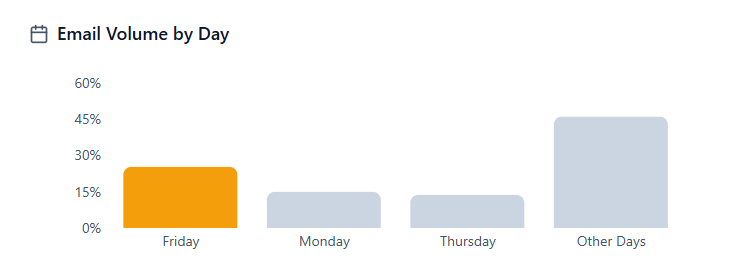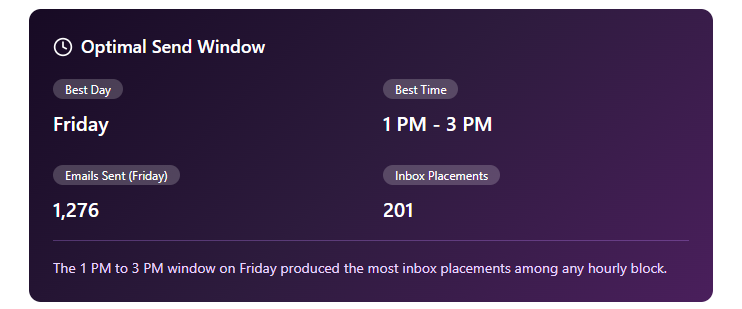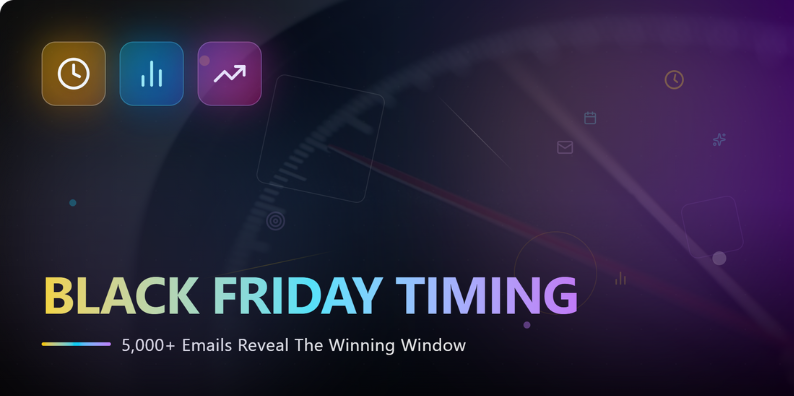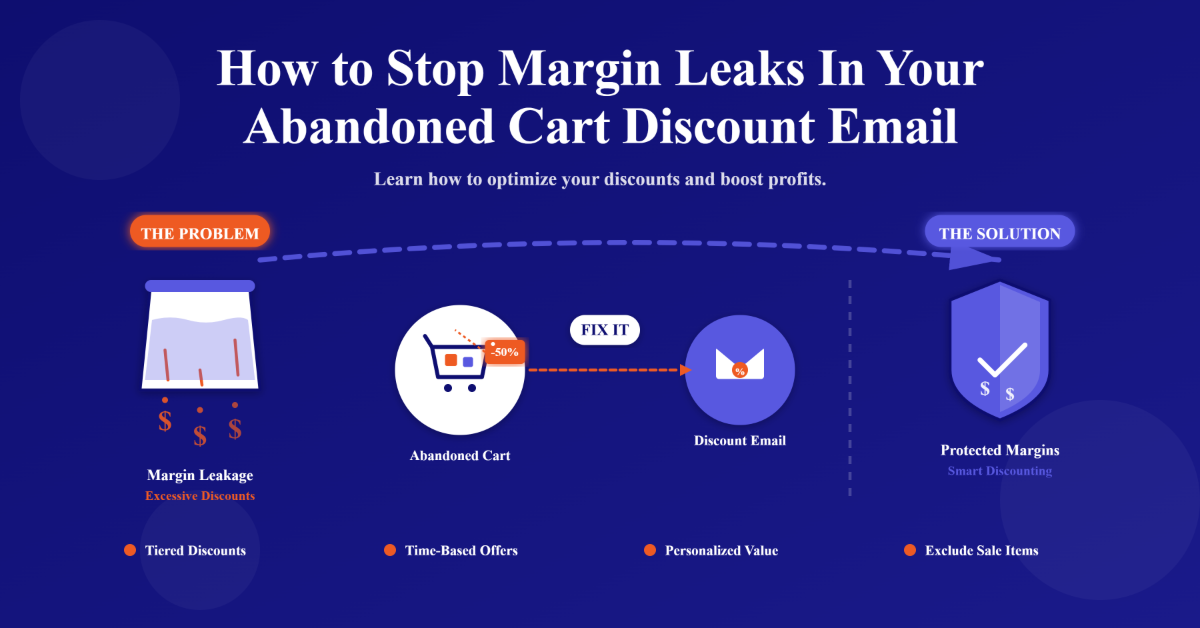Quick Summary
Our data shows that Friday between 1 PM and 3 PM is the most reliable inbox window for Black Friday campaigns.
Among all hours analyzed, 1 PM achieved the most frequent inbox placement at 14.29%, while 4 PM and 5 PM saw the highest spam placement at 12.30% and 11.48%.
Friday also represented the largest share of sends overall at 25.29%, with Monday and Thursday following.
While a portion of messages will still route to the Promotions tab, the most inbox-friendly slot is Friday early afternoon, sent in local time to each subscriber’s region.
We analyzed 5,025 emails from 1,404 brands over 399 days and found a clear pattern: the inbox opens widest on Friday in the early afternoon, while late afternoon spikes the risk of spam.
If you’ve been wondering about the Best Time To Send Black Friday Email, the data points to a practical, high-confidence answer.
What the Data Says About Inbox Timing
This analysis draws from 5,025 emails across 1,404 brands, tracked over 399 days.
The goal was straightforward: identify the hours and days that most often coincide with inbox placement and flag the windows connected to higher spam risk.

Two hourly markers stand out. At 1 PM, inbox placement took the lead with 14.29% of occurrences. At 5 PM, inbox placement still appeared, but at a notably lower 9.09%.
At the same time, the late afternoon raised a red flag. The most frequent spam placement appeared at 4 PM with 12.30% and at 5 PM with 11.48%. The overlap at 5 PM is a caution sign.
While some brands can still land in the inbox late in the day, that window carries more risk and demands tighter list hygiene and segmentation to avoid a deliverability slip.
Interpreting this, the early afternoon appears to be a sweet spot for inboxing. The late afternoon shows mixed signals with increased spam frequency.
For Black Friday, cutting through the noise means choosing a window where mailbox providers are more permissive and where shopper attention is naturally high.
Friday Wins, But the Hour Matters
Volume and visibility align on one specific day. Friday accounted for 25.29% of the emails in our dataset, with Monday at 14.95% and Thursday at 13.69%.
High send volume alone doesn’t prove performance, so we looked specifically at the messages that landed in the inbox. Friday emerged again as the lead, with 1,276 emails sent and the 1 PM to 3 PM window producing 201 email sends, the most among any hourly block.

This suggests Friday early afternoon isn’t just when brands hit send; it’s also when inbox placement is most consistently achieved. The combination of shopper intent, active browsing behavior, and recency of offers appears to boost visibility. It’s also late enough in the day to catch lunch-break scrolling, and early enough to avoid the late-afternoon spam spike.
If you’re choosing a single primary drop for your major Black Friday push, the data-backed choice for the Best Time To Send Black Friday Email is Friday between 1 PM and 3 PM in each subscriber’s local time.
Turning Insights Into a Black Friday Send Plan
The practical next step is to translate timing insights into a structured send plan for Black Friday week.
Treat Friday early afternoon as your anchor slot, then build a supportive cadence that primes demand and captures late movers without triggering deliverability issues.
Start with a warm-up earlier in the week. Monday holds the second-highest share of sends in our dataset and serves as a convenient stage for previews or opt-in confirmations.

Consider making Monday a VIP or loyalty early-access announcement that invites subscribers to set preferences, save items to wish lists, or claim early coupons. This nudges engagement up before your big send and signals positive activity to mailbox providers.
Use Thursday for final reminders and sale details. Thursday can deliver the last pre-launch touch, aligning expectations and boosting intent. If you send on Thursday, choose a safer time window like late morning or early afternoon rather than late afternoon.
The data indicates spam risk rises at 4 PM and 5 PM, so placing your reminder earlier helps preserve inbox health for the main event.
On Friday, launch the primary sale send in the 1 PM to 3 PM window. This is your conversion driver. Keep a tight audience definition, suppress chronic non-openers, and localize send time to each recipient’s time zone.
If you plan a second Friday send, consider a smaller segment with an alternate angle, but avoid packing it into 4 PM or 5 PM where the spam rate is most common.
Finally, plan for a follow-up to non-openers or clickers who haven’t purchased, but do it strategically. If your Friday follow-up risks entering the late-afternoon spam-prone window, shift it earlier or push it to early Saturday with a limited, best-fit segment.
Local Time Zones and List Segmentation
Localizing delivery is table stakes for high-stakes days like Black Friday. A 1 PM send in New York should not arrive at 1 PM in London or Sydney unless you intend to run regional waves.
The simplest approach is to schedule rolling sends at 1 PM to 3 PM local time for each major market group. If your list spans multiple regions in the United States, segment by time zone and cascade releases from East to West.
Refine by engagement tiers as well. Highly engaged subscribers can receive your main send as planned, while less active segments may perform better with softer messaging and lower frequency.
The goal is to reduce risk while maintaining reach in your most valuable windows.
Pre-Warm, Prime, and Follow-Up Without Over-Sending
A high-performing Black Friday email sequence usually pairs a strong Friday drop with pre-warm and post-launch touches.
Start with a simple Monday message that sets expectations, clarifies start times, and builds anticipation. Midweek, highlight key deals for loyalty members along with clear savings visuals and a direct path to category pages or curated bundles.
On Friday, keep the creative focused and value-forward. If inventory allows, consider a gentle secondary nudge to a small, high-intent segment later in the day, but be mindful of the late afternoon spam pattern.
Over-sending can push mail providers to throttle, filter, or tab your messages unfavorably, especially when the entire market is mailing at the same time.
Avoid the Spam Trap in the Afternoon
Our dataset shows the most common Black Friday email spam placement at 4 PM and 5 PM. If your calendar pressures you to send in this window, mitigate risk by tightening the audience and message design.
Focus on active segments from the last 30 to 90 days, and suppress disengaged addresses. Keep subject lines direct and clear rather than relying on aggressive urgency or excessive symbols, which can lower deliverability.
Ensure your authentication is spotless. SPF, DKIM, and DMARC need to be in place, aligned, and monitored. Maintain a consistent from-name and reply-to address across the week.
If you’ve run heavy list growth in the weeks leading up to Black Friday, consider segmenting new subscribers separately and limiting their send frequency until they show positive engagement signals.
Content and Design Choices That Protect Inbox Placement
Relevance is the most reliable inbox booster. Personalize the offer to the subscriber’s category interest or past purchase behavior.
Keep the hero offer above the fold, but balance imagery with concise copy so your message loads fast on mobile connections. Test subject lines that foreground savings or shipping windows without resorting to excessive punctuation.
Maintain brand consistency, especially during Black Friday when consumers receive dozens of messages per day. Visual cohesion across your Monday warm-up, Thursday reminder, and Friday launch helps subscribers recognize and trust your communications.
Test a shorter preheader rather than a second headline, and link directly to the featured deal or collection page to reduce friction.
Measuring Success Beyond the Inbox
Inbox placement matters, but it’s not the only indicator of performance. Some messages will enter the Promotions tab, which still converts well for commerce when the value is clear.
Track revenue per recipient, click-to-purchase rate, and time to first purchase after open to understand whether your chosen window is attracting buyers or just opens.
Pair that with cohort-level analysis. Evaluate how Monday preview openers behave on Friday, whether Thursday reminder clickers convert faster, and what Friday early afternoon buyers do across the rest of the weekend.
This gives you confidence to either double down on Friday early afternoon or expand to secondary windows that are working for specific segments.
Sample Timing Scenarios for Common eCommerce Categories
Fashion brands often benefit from visual storytelling and outfit bundles.
Send the main Friday black-and-white offer at 1 PM local time, then use a lighter creative for a small segment of high-intent browsers who added to cart but didn’t purchase by late morning Saturday.
Keep Thursday as a curated lookbook to prime interest without overloading late afternoon.
Electronics sellers can lean into specs and savings clarity. Monday can preview warranty or bundle advantages, Thursday can highlight doorbusters, and Friday’s 1 PM to 3 PM drop should emphasize scarcity with real inventory counts or shipping cutoffs.
Avoid packing a second send into the 4 PM to 5 PM block where spam placement is most likely.
Home and lifestyle brands often see success with room-by-room or use-case curation. A Monday inspiration piece, a Thursday checklist, and a Friday 1 PM main send reinforce the journey from idea to purchase.
If you must run a late Friday reminder, make it highly tailored to engaged non-buyers and keep the copy calm and benefit-led.
How TargetBay Helps You Execute the Timing That Works
Hitting the Best Time To Send Black Friday Email requires more than guesswork. TargetBay Email & SMS can localize delivery by time zone, segment by engagement, and schedule sends in the 1 PM to 3 PM window, where inbox placement is most common in our data.
The AI email agent can help shape subject lines and message variations without bloating your schedule.
Beyond the send, TargetBay Reviews adds rich social proof that lifts conversion during high-traffic windows, and TargetBay Rewards helps you create early-access benefits for your best customers without over-mailing the entire list.
Together, these tools let you orchestrate timing, relevance, and loyalty with fewer moving parts.
The Bottom Line on Black Friday Timing
Across 5,025 emails, one insight stood out. The Best Time To Send a Black Friday Email is Friday between 1 PM and 3 PM, with 1 PM producing the most frequent inbox placement at 14.29%.
Beware the late afternoon, where 4 PM and 5 PM appear most often in spam. Use Monday and Thursday strategically to prime demand, segment by time zone and engagement, and keep a lean, relevant creative to protect deliverability.
Great timing works best when your entire stack is aligned. A unified approach with TargetBay’s Email & SMS, Reviews, and Rewards helps eCommerce brands turn the right window into real revenue, all while keeping messages where they belong, the inbox.






